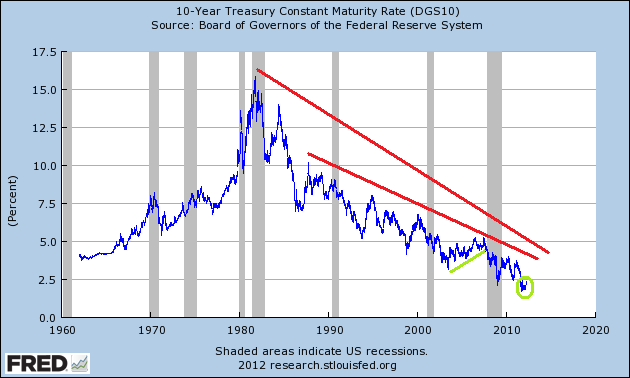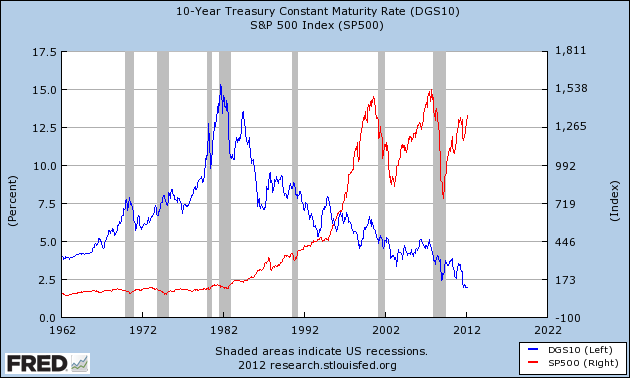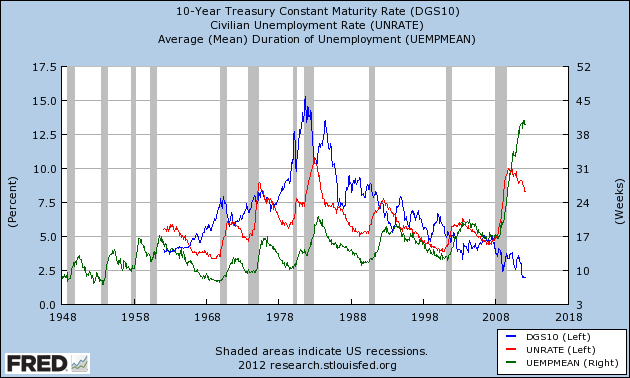
I wanted to write this piece today to have a look at bond markets globally and what they might, or might not, be trying to tell us about the future not just of the economy but of assets more broadly.
As the recovery in the US economy appears to be gaining traction the bond market has started to sell off a little and I am increasingly reading that the long run secular bond market rally is now at an end. Certainly with accomodative Fed policy and particulalry two rounds of quantitative easing it looks like a reasonable time to posit the rally is over. Indeed mathematically, like shorter maturity US Treasuries, the closer we get to zero the more likely it is we are nearing an end of the rally.
But that does not mean that a massive bond market rout and sell off is necessarily in the offing.
Let’s look at a few charts:

Here is the yield on US 10 year Treasuries since early 1962 – you can see clearly from the two red lines that there has been a massive rally from the high in 1980 and then, from a chartists point of view a more beautiful downtrend with multiple touches and rejections since the late 1980’s. The greyed areas are the official US recessions and you can see that this bond market rally has persisted, in a broad sense, regardless of economic growth and regardless of the run up in equity markets:

The bond market just kept rallying on, no doubt driven by changes to central banking and a focus on maintaining inflation. Certainly there have been material hiccups, as we saw back in 1994 when those us managing interest rate books felt the full force of the bond market vigilantes as they used to be called. Luckily from a personal point of view I had two very experienced fund managers with me at NSW State Super who helped my brash 25 year self through the sell off and we did what we usually did and performed very well that year.
But what of the potential bond market rout of 2012 – The Economist magazine’s Buttonwood Column wrote last week about the 60 point rise from the lows of last September up until the recent print around 2.3%:
A rise in yields from what were very low levels, in historical terms, is not that surprising. The economic data have been better than expected since the start of the year, particularly in America, calming fears of a global recession. A torrent of central-bank loans to euro-zone banks and Greece’s debt-restructuring deal have made investors less nervous about a break-up of the euro, removing the appeal of Treasury bonds as a haven.
The big question is whether this is a turning-point in the bond market.
Yes indeed. Certainly it appears that the Australian Economics team at UBS lead by Scott Haslem reckon the lows are in – this from yesterday’s daily update:
Markets are gradually realising the improvement in the US (and global) economy is durable. Improved US bank lending conditions have bolstered jobs and consumption. This is combined with reduced ‘tail risks’ around Greece, and the Fed being slightly more upbeat on the growth outlook. Hence, markets are starting to unwind pricing of QE3, and we also expect the Fed to hike from mid-13, a year ahead of their ‘signal’. Further, the European recession is milder than expected. Finally, we also expect Chinese and EM growth to rebound, after dipping in 1H12.
Hence, our US team raised 10-year yield forecasts by 30bp for end-12 to 2.7%, and end-13 to 3.3%. However, as rising yields reflect improved growth expectations & reduced risk, the UBS Global Asset Allocation team remain overweight equities.
Rightyo – seems a reasonable idea which obviously has implications for Australian bond markets, swap spreads and ultimately also the rates that are available on fixed rate home loans in the Australian mortgage market.
But the UBS guys aren’t only calling a bottom in bond yields, both in the US and here, but rather they are calling a bear market in bonds. To my mind, in a time of fragile global and domestic growth such would completely derail the recovery and knock Australia pretty hard given current settings.
Chris Watling of Longview Economics in Buttonwood says:
The big bear markets in bonds were associated with higher inflation. There was a brief inflationary period associated with the first world war and a much longer burst of rising prices after the second world war which culminated in the 1970s. Some fear the inevitable response to the current crisis is that countries will attempt to inflate away their debt.
But there is not much sign of this in the consumer-price indices. Inflation is expected to average 2-2.5% this year in America, Britain and the euro zone. And bond investors do not seem to be too concerned about the near future, to judge by the breakeven inflation rates (the gap between the yield on conventional and inflation-linked bonds). These reached a nadir of just under 1.5% (for five-year bonds) in September and are now up to 2.1%; for ten-year bonds, there has been a move from 1.7% to 2.4%. But those rates are still consistent with central-bank inflation targets.
I agree wholeheartedly and I don’t see a material or lasting uptick in inflation coming down the pipeline at present to change the outlook on that front.
On this note over at Business Indsider on the weekend I picked up a piece which included a discussion with one of my favourite economists and the doyen of the bond market rally, Gary Shilling:
Shilling does not think the economic recovery is gaining steam. He thinks analysts are much too optimistic about earnings for this year, and he thinks the recent resurgence in hiring is not the result of companies being optimistic about the future but because productivity gains are declining and companies need to hire to grow revenue and earnings. In contrast to those who have recently called the bottom in house prices, Shilling also thinks house prices have another 20% to fall.
In light of all this, Shilling still thinks deflation is a bigger problem than inflation. He’s looking for the 30-year Treasury yield to drop back to 2.5%
My view is that we are once again seeing a false dawn in the US economy and I wonder about the economy and the types of jobs it has been creating. To wit, an interesting piece on Zero Hedge over the weekend quoted some work done by JP Morgan on the quality of jobs being created in the US economy at the moment:
The conclusion is staggering – everything we know about the economic virtuous cycle is now irrelevant!
The new pattern of productivity growth—no longer cyclical with respect to output and countercyclical with respect to employment—has several important implications. For one, we may continue to see the unemployment rate drop more than Okun’s Law implies. Another implication is that the labor share is no longer countercyclical. This also means that profits will be less correlated with improvements in the labor market.A final, somewhat technical, implication is that the conditions for self-fulfilling prophesies in the macroeconomy may no longer exist. The idea that there could exist virtuous/vicious circles between real economic outcomes and confidence (or asset prices, effectively the same thing) was first formally advanced by David Cass and Carl Shell. They referred to these virtuous/vicious circles as “sunspot equilibria;” George Soros dubbed the property “reflexivity.” Subsequent applied macroeconomists appealed to the procyclicality of productivity as evidence of the type of increasing returns to production sufficient to generate confidence feedback loops. If labor is no longer a quasi-fixed factor of production this may eliminate one type of non-convexity in production, thereby reducing the likelihood that the economy has multiple equilibria and is subject to self-fulfilling prophecies. While it is hard to say much definitively, it is interesting to observe that over the last two years the economy has been subject to large swings in investor sentiment and asset prices, and yet actual growth outcomes have been remarkably stable.
So jobs are being created but the quality is not so hot and the income to be derived from them and thus the multiplier impacts on the rest of the economy will be lower than the historical context suggests.
Indeed check out this chart with the US 10 year rate, unemployment rate and average length, duration, of unemployment (the green line) – speaks volumes I reckon.

All this, when you add back Europe’s enduring malaise, an uncertain Chinese slowdown, high oil prices and the PMI flows and the recent bond market selloff looks more a part of the current flow of market sentiment and overall uptick in risk appetite. It might sound a little rude but I reckon strategists and economists might just be trying to be able to say they called the turn. If I had a hundred bucks for every article or strategy note I’ve read in the past few weeks talking about the death of the 30 year plus bond market I’d have the kids college fund fully paid up and funded.
I tend to agree with the way Buttonwood finished the article I quoted above:
Given these risks, it is not difficult to construct a bearish scenario for bonds. Indeed, central banks were also holding short rates at very low levels at the last nadir for bond yields in the late 1940s (a moment when, as now, governments were trying to deal with accumulated debts).
But even if bond yields have touched the bottom for this long cycle, it is worth remembering that the period of low yields in the 1940s was quite protracted, lasting eight years or so. In the short term, if yields were to rise too far, to 3% or so, central banks could always step in with another round of quantitative easing. The great bear market in bonds may have begun but the decline will not necessarily be precipitous.
Developed economies are still ladden with too much debt and this crisis might be getting closer to the end than the beginning finally but for mine I’m not betting on the Bond Bear just yet – the global economy just couldn’t bear it.
Have a great day,
Gregory McKenna
www.twitter.com/gregorymckenna
Please remember these are not recommendations for you to trade these are my views and I have my risk management tools and risk parameters that you do not have access to. Thus, this blog is for information only and does not constitute advice. Neither Greg McKenna nor Lighthouse Securities has taken your personal circumstances, objectives or financial situation into account. Because of this you should, before acting on this information, consider its appropriateness, having regard to your objectives, financial situation or needs.